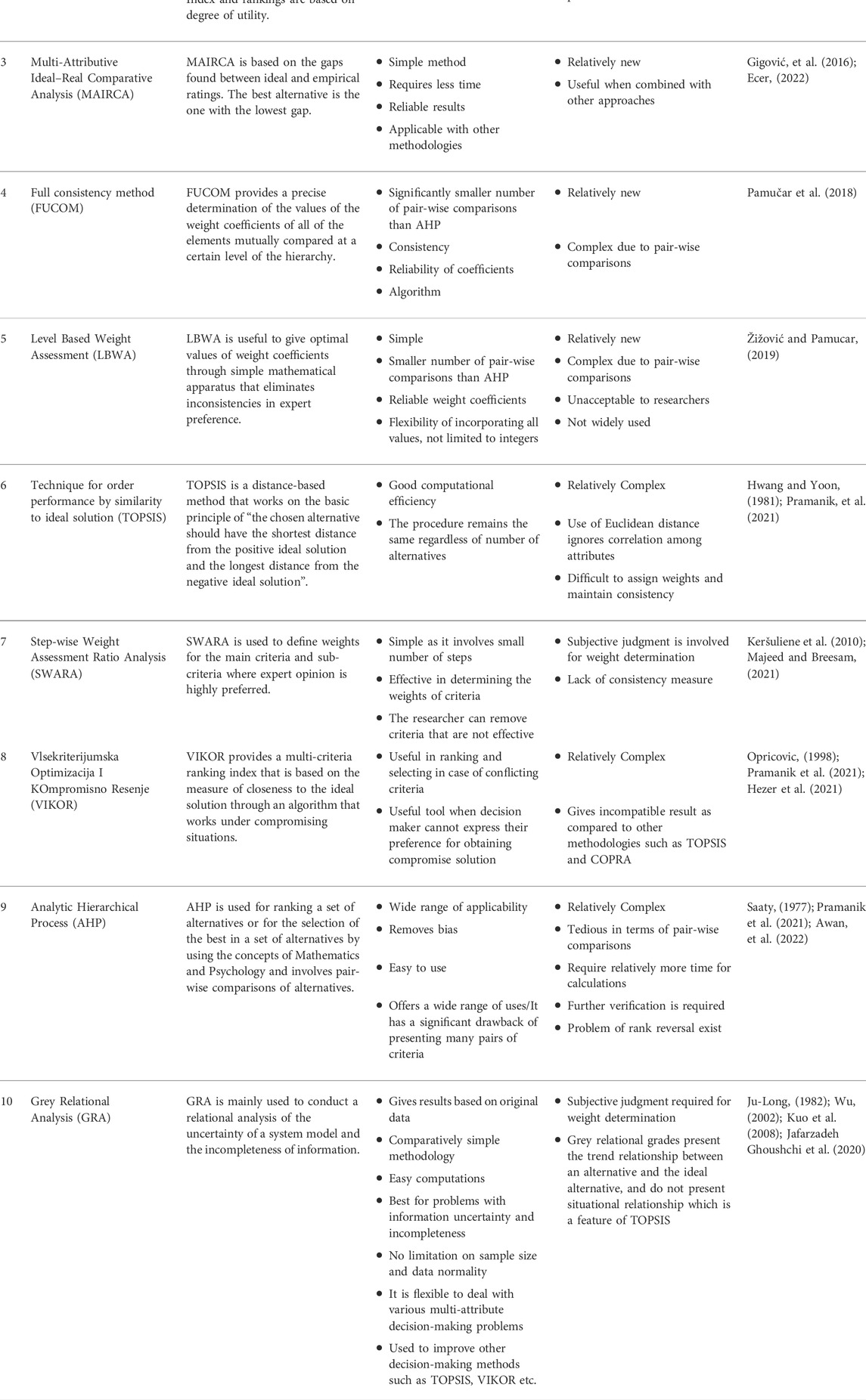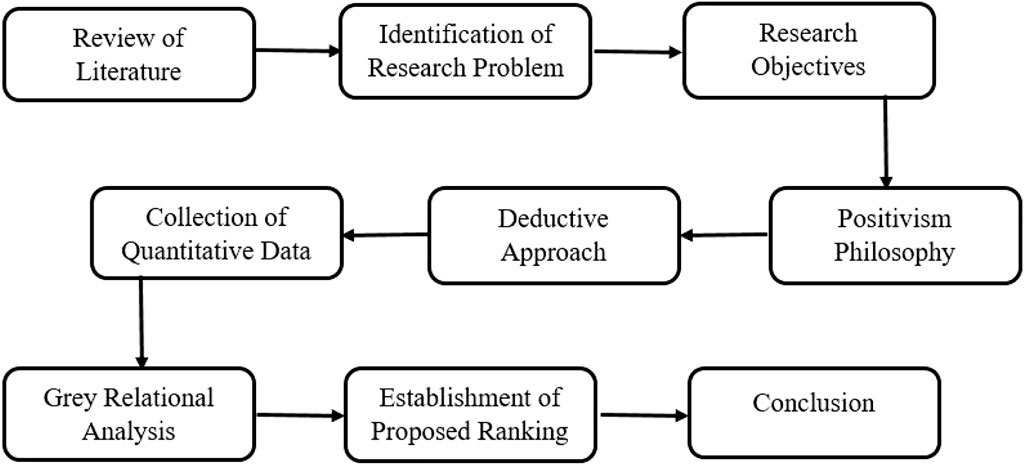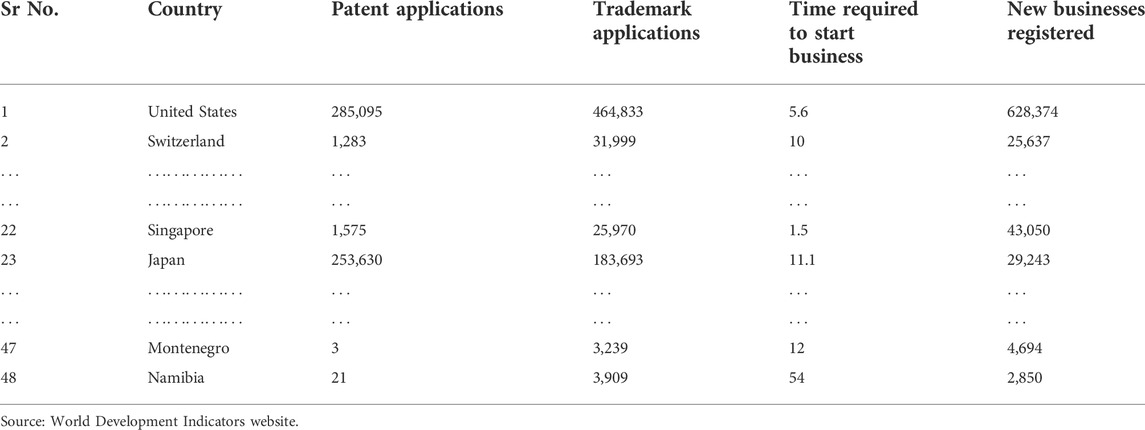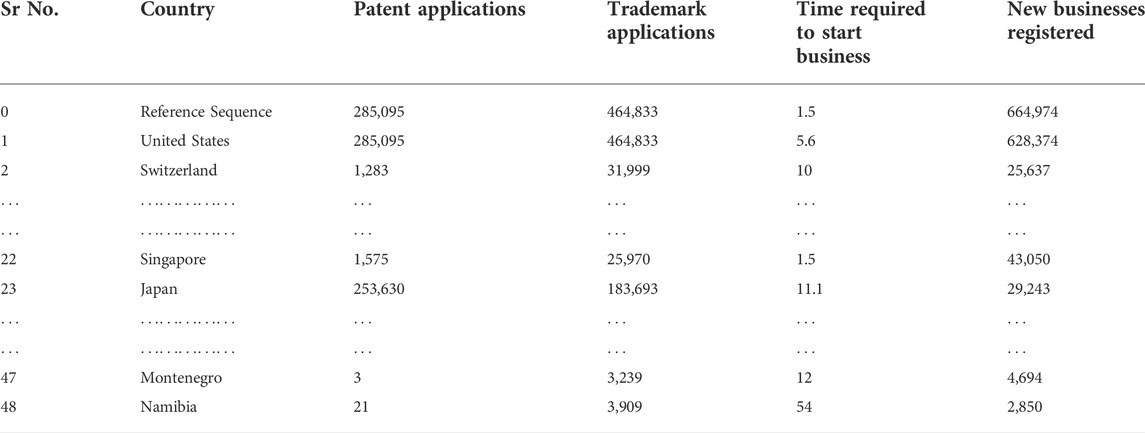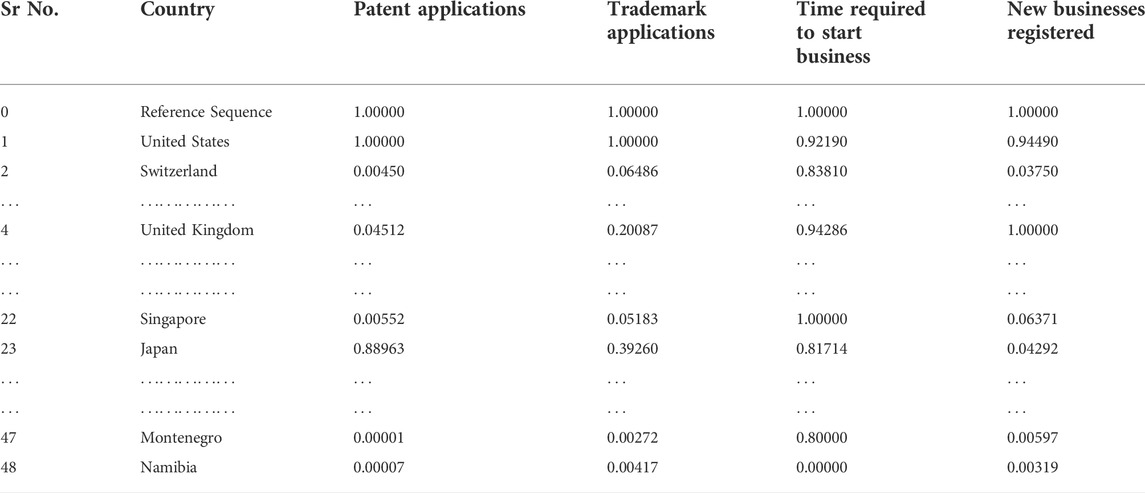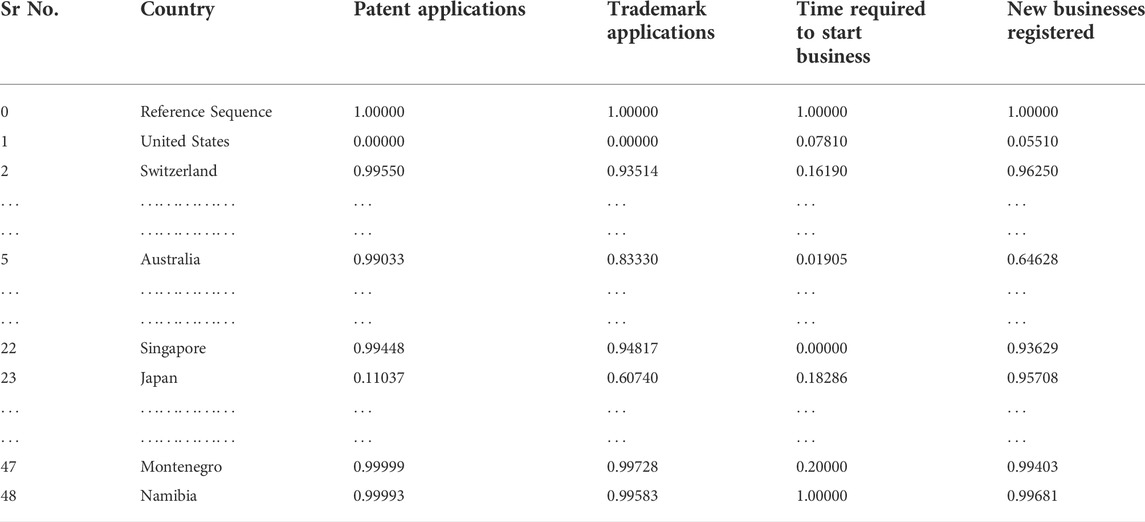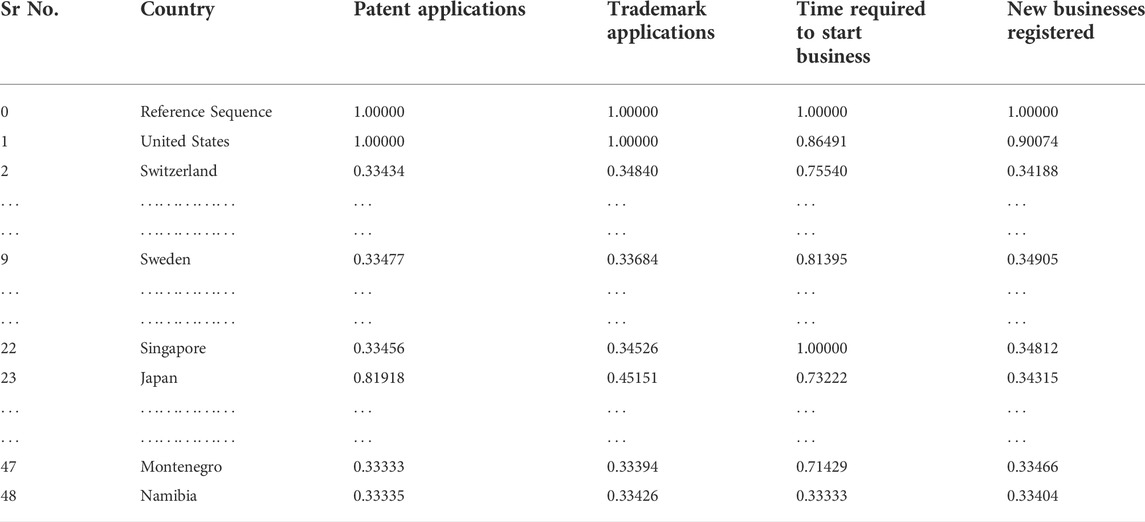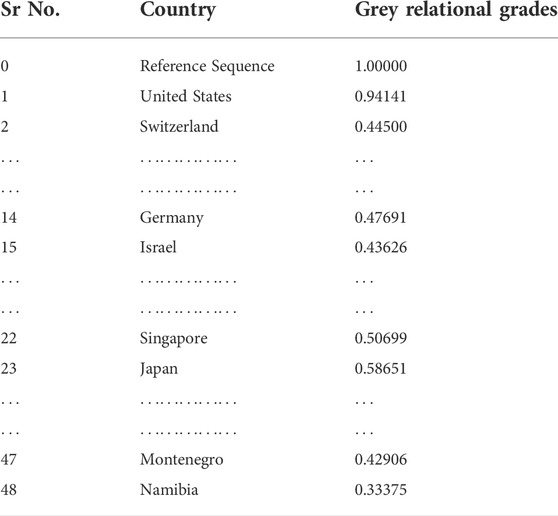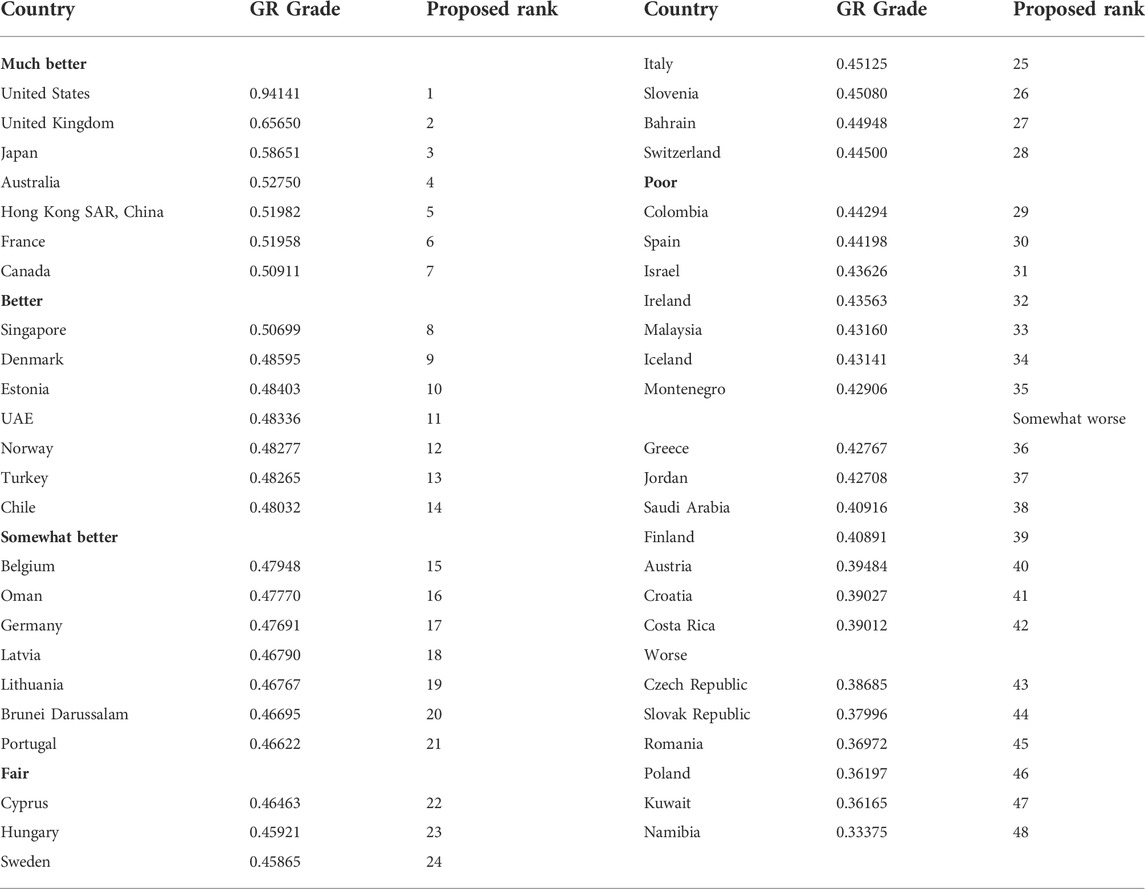Grey relational analysis of country-level entrepreneurial environment: A study of selected forty-eight countries
- 1Changsha University of Science and Technology, Tianxin District Changsha, Hunan, China
- 2Department of Management Sciences, National University of Modern Languages, Multan Campus, Multan, Pakistan
- 3Hunan University of Science and Technology, District Xiangtan, Hunan, China
- 4Institute of Business and Management, University of Engineering and Technology, Lahore, Pakistan
- 5Department of Management Sciences, Kinnaird College for Women, Lahore, Pakistan
The aim of this study is to evaluate the entrepreneurial environment of selected countries, and analyze and rank them on the basis of entrepreneurship related indicators. This study’s design comprises a review of the literature, extraction of secondary data on the phenomenon, and analysis. The research gap has been established through a review of the literature, leading toward the development of problem statement. The cross-sectional data, related to entrepreneurship indicators, is extracted from website of World Development Indicators (2021) for 48 selected countries. Using positivism as a research philosophy and deduction as a research approach, the data are analyzed through grey relational analysis (GRA). On the basis of grey relational grades, this study also classified the countries on the continuum of “much better” to “worse.” The results of the study show that the United States, United Kingdom, Japan, Australia, Hong Kong SAR, China, France and Canada attained the highest grey relational grades and are considered the countries having much better entrepreneurial environment; whereas Poland, Kuwait, Namibia and so on attained the lowest grey relational grades and are considered the countries having worst entrepreneurial environment. This research has several practical implications for different economies/countries, entrepreneurial ventures, aspiring entrepreneurial, and researchers. On the basis of findings of this study, policy makers should refine country-level entrepreneurial policies while keeping in view the respective grey relational grades.
Introduction
Economic development is considered as a hallmark of a healthy economy. However, both developed and developing countries are struggling with the challenge of ensuring the increase in growth and the development of their economies (Awan and Sroufe, 2022). One of the most important ways to overcome this challenge is through entrepreneurship supporting policies, especially those policies that support technological innovation and lead toward the creation of high value added products and services at micro level for small or medium sized enterprises (Ács et al., 2017; Kanwal and Awan, 2021). Knowledge intensive entrepreneurial activities are assumed to be the key competitiveness of a country in this regard (Hébert and Link, 2006). Because entrepreneurial firms are innovative and resilient, that they are quite able to recover very swiftly when economic downturns take place (Wymenga et al., 2011). Kanwal and Awan (2021) argued that leveraging sustainable innovations can provide support to the entrepreneurial environment of a country. In the same way, entrepreneurial firms create new skill-based jobs, they also introduce new and innovative products and services. These beneficial outcomes of entrepreneurial activities and ventures result in the reduction of inefficiencies in the processes, and the betterment and prosperity of the economic system of these countries. A conducive entrepreneurial environment is vital for economic development. Awan (2021) argued that in this era of innovation and invention, entrepreneurial activities have become complex and challenging, but at the same time it can provide leverage in gearing up developments. Wennekers (2006) reports that it has become imperative to evaluate the country-level performance of the entrepreneurship environment. However, more theoretical evidence and interpretation is needed regarding the entrepreneurial environment of different countries. One way of addressing this issue is to rank countries with respect to the leading economies. In this regard, the Global Entrepreneurship Index (GEI) is considered as an important ranking system for the countries worldwide based on the assessment of entrepreneurial activities in those countries. It has been ranking countries since 2009, and uses individual factors for this purpose. The data that is used by GEI is mainly drawn from the Global Entrepreneurship Monitor (GEM), which is a prestigious institution and provides the individual factor-related data for ranking purposes. Although GEI provides much valuable data regarding the ranking of countries based on entrepreneurial activities and entrepreneurial environment of the countries, GEM does not provide data for all the countries worldwide that are not members to this index. In fact, limited data are available on GEI, which gives accordingly limited insights. There are other sources of country-level data, such as World Development Indicators (WDI), that provide information regarding entrepreneurial activities. A clear picture of entrepreneurial environment in different countries is needed so that the policies can be developed accordingly. There is a clear research gap of country-level analysis of entrepreneurial activities, which has motivated the authors of this paper. This study is an attempt to close the gap in the prior literature by providing theoretical support. Therefore, the objectives of the study are: 1) to evaluate entrepreneurial environment of countries; and 2) to analyze, 3) rank and 4) categorize these countries against the continuum of “much better” to “worse” on the basis of entrepreneurship related activities. To achieve these objectives, this study has considered different databases for extracting the country-level secondary data sets, and has used the techniques of analysis, ranking, and categorization. The data available on WDI is considered the most suitable because it is an authentic source of data. Therefore, the data is extracted for analysis from website of WDI. An array of techniques of data analysis is considered, such as MABAC, COPRAS, MAIRCA, FUCOM, LBWA, TOPSIS, SWARA, VIKOR, GRA, AHP and so on. However, on the basis of simplicity, comprehensiveness and appropriateness, GRA is considered to be the most suitable technique to achieve the objectives of this study (Wu, 2002; Niazi et al., 2021a; Qazi et al., 2021a; Awan, et al., 2022). Asgharnezhad and Darestani (2022) applied Dempster–Shafer theory and grey relational analysis (GRA), and found that GRA is the more robust and more reliable technique of analysis. Gerus-Gościewska and Gościewski (2022) asserted that GRA could be applied to solve practical problems related to social participation. A comparison on the basis of advantages and disadvantages was developed, and a scientific comparison was made among the competing methodologies (see Table 1).
GRA solves MCDM’s problems by aggregating all of the performance attribute values for every alternative into a single value. This is used to improve decision-making capabilities of other methods (e.g., TOPSIS, VIKOR etc.) that use only positive and negative criteria. In reality, certain cases have neither positive nor negative criteria and are presented as a number, such as “number of trademark applications.” In these cases, GRA fits best to rank the alternatives having multi-criteria by aggregating all of the criteria into a single value (Jafarzadeh Ghoushchi et al., 2020). Despite its limitations, GRA is still considered to be the most recent and preferred technique out of the available MCDM techniques to rank multi-criteria alternatives. From this comparison of MCDM approaches, the authors find that GRA is the most suitable technique to deal with the problem in hand. This is an original study because it uses a real-time authentic data set that is analyzed on scientific basis. It gives valuable information to all the stakeholders regarding entrepreneurial environment of the countries. It also makes a number of theoretical contributions by way of grey relational grades, ranking, and classification of countries. The grades, ranking, and classification have practical and theoretical implications for governments/policy makers and entrepreneurs (current and potential). The innovative value of the contribution of this study is as follows: 1) new combination of variables for assessing entrepreneurial environment, 2) better and highly reliable data set, 3) relatively recent and preferred methodology, 4) normalized composite values for ranking and comparing every alternative with the best among the set of alternatives, and 5) novel scheme of ensigns by way of classifying countries on the continuum of “much better” to “worse” entrepreneurial environment. The remainder of the paper includes a literature review, methodology, analysis, results and discussion, and conclusion.
Literature review
The purpose of the current research is to rank countries based on various indicators related to entrepreneurial environment. In this context, this literature review has been conducted to analyze the present literature on the topic to identify the research gaps in the field and to bridge them. There has been considerably less research on the ranking of countries based on entrepreneurial environment but there are different indices that somehow provide an image of such ranking (e.g., GEM, GEI etc.). This literature review will explore how these indices have ranked the countries and how entrepreneurship is important on the whole. First, the prestigious entrepreneurial indices such as GEI and GEM have been reviewed, along with various indicators that are crucial for the determination of entrepreneurial environment of a country. Second, entrepreneurship is explored in the context of its importance and its various dimensions that might be important while determining of entrepreneurial environment of a country. Third, only those countries whose data is available on world development indicators are selected. Finally, the status of research conducted on entrepreneurship in the past has been reviewed. The databases explored for the purpose of literature review include Elsevier, Emerald, Sage Publications, Taylor and Francis, Springer, Wiley-Online, Google Scholar and so on. For the literature search, the important keywords used include “entrepreneurship,” “ranking,” “Global Entrepreneurship Index,” “Global Entrepreneurship Monitor” “GEI classification,” “entrepreneurial activities of countries” and so on. Initially, 67 research papers were downloaded from these databases. After an initial review of the abstracts and filtering, 37 papers were removed and only 30 were selected for the final review. The papers that were directly associated with different ranking systems, entrepreneurial indices, and indicators were selected on priority basis for review. Moreover, the papers with general importance of entrepreneurship and its role in different economies were also selected to gain a broader perspective of the topic. Those papers in which entrepreneurship was used just as one variable and did not play a major role in the implications of the research were excluded. The papers referred to in the current study are as old as 1982 and as new as 2022. A comprehensive review of the contemporary literature follows.
Indicators to assess a country’s entrepreneurship level
In the recent literature, several researches have explored different indicators and the ranking procedures on the basis of a country’s entrepreneurship environment. For example, a study was conducted based on Global Entrepreneurship and Development Index GEDI that captures the contextual feature of entrepreneurship across countries, which suggested that public policies should be more mature before entrepreneurial resource deployment (Acs and Szerb, 2010). Another related study summarized the history of GEM along with its contributions, as well as the challenges and opportunities to be faced in future (Levie et al., 2014). Cheng et al. (2021) focused on the fourth Industrial Revolution and sustainable growth, and concluded that innovation and fiscal decentralization affects entrepreneurial the environment to a great extent. A cross-national analysis based on 64 countries using fuzzy-set quantitative comparison analysis of financial, innovation, and sustainable development condition that boost entrepreneurship condition of country suggested that the entrepreneurship level of a country is related to both innovation level and country risk source (Awan, 2021; Cervelló-Royo et al., 2022). Fang et al. (2022) investigated the regional competitiveness of various nations using GRA grades and identified the critical underlying factors. Their findings reveal that India, Singapore, and Australia have regional competitive advantages where labor force and technology are considered indispensable factors for regional competitiveness. Aydemir and Sahin (2019) asserted that service quality and customer satisfaction are different structures for customers. A systemic conceptual approach was used by Kantis et al. (2020) to direct the design of entrepreneurship policies, which was based on the data of Index of Dynamic Entrepreneurship IDE. A study of the entrepreneurial indicators addresses aggregate performance indicators in national system of entrepreneurship from an efficiency viewpoint raised the necessity for policy makers to develop more comprehensive knowledge concerning their own entrepreneurial ecosystem (Dionisio et al., 2021). To find the link between aid with informal and formal entrepreneurship, Moore et al. (2020) collected data from 2016 with a sample size of 313 from 49 countries. Their findings show that there is a robust impact: bilateral aid and private aid are associated with higher level of informal entrepreneurship. To understand relation of social entrepreneurship with SEA prevalence rates, data from 49 countries were collected and analyzed on the bases of GEM methodologies of TEA, indicating that high traditional entrepreneurial countries are also high rate achievements in social entrepreneurial activities (Lepoutre et al., 2013). Stefan et al. (2021) found that cultural heritage, trademark, and the facilities offered by a specific area are considered to be important for choosing among the alternatives for entrepreneurial development, whereas the level of accessibility is not considered important for certain investment decision. The history and cultural heritage of a place are important. Considering these elements, the best investment decision alternative is found to be located near the national and European interests’ cultural heritage elements. To understand the relationship of national culture with entrepreneurial activities by measuring GDP per capita, an analysis of 52 countries’ data was conducted by Pinillos and Reyes (2011). Their results show that a country’s entrepreneurship is negatively related to individualism when development is medium or low, whereas it is positively related to individualism when the level of development is high. Meanwhile, Tasnim and Afzal (2018) examined the effect of entrepreneurship on country-level efficiency by analyzing data of 59 countries through the Tobit model and Tobit regression model. They concluded that factor driven countries are efficient, while innovation-driven economies are the most effective. Amorós et al. (2013) aimed to explain the history, accomplishments, and prospects of GEM. Initially, GEM measured countries’ entrepreneurial activity differences by way of exploring the factors that indicate entrepreneurial activity of countries and the policies for the stimulation of entrepreneurship.
Entrepreneurship and its dimensions
With the passage of time, various prospects and dimensions of entrepreneurship have evolved. For example, Qian et al. (2021) examined the support of various stakeholders (e.g., families, communities, or business partners), which helps to avoid institutional voids and foster entrepreneurship. Moreover, the adoption of digital technologies has been examined. The authors analyzed data from more than 1,000 micro-entrepreneurs in rural India. Their results indicated that both families and communities have a positive and significant effect on entrepreneurship, which is strengthened more when digital technologies used. Other similar studies have reviewed and analyzed how digital technologies foster the birth, development, and growth of new ventures, and how the companies use these technologies (Awan and Jabbour, 2022; Zahra et al., 2022). Afawubo and Noglo (2022) investigated the impact of information and communication technologies (ICTs), addressed by ICT capital services on total entrepreneurial activity (TEA) in emerging and developed nations, and found out that it is applicable in developed countries only and is not applicable in developing countries. Gu and Wang (2022) asserted that sustainable entrepreneurship is necessary to promote regional economic growth. Furthermore, sustainable entrepreneurship plays mediating role influencing regional economic growth through technical R&D and financial intermediaries play a moderating role in the first half of the path (Awan, 2021). In the context of the entrepreneurial ecosystem, the supportive role of regional governments in underdeveloped institutional environments was studied along with other related key elements. Wei (2022) collected data from China between 1993 and 2013, and found that there is positive relation between core function performing regional government and opportunity entrepreneurship growth in underdeveloped institutional environments. Afza and Rashid (2009) aimed to discover and characterize the obstacles in the environment that prevent remote entrepreneur women to grow and become successful entrepreneurs in Pakistan. They collected primary data through interviews from remote entrepreneur women from different cities of Pakistan. It was found that many barriers (e.g., sexual discrimination, limited educational opportunities and absence of self-actualization and weaker family support) prevent these women from taking advantage of growth opportunities. Baycan-Levent and Nijkamp (2009) explored the factors of migrant entrepreneurship in eight European countries. Their results indicated that open markets of European migrants are determined by some push factors, such as unemployment and low participation. Qian and Liu (2018) aimed to recognize the driving force for urban and regional economic development. The results of their multivariate regression analysis showed many positive and negative connections in cultural entrepreneurship and general startup. Bergmann (2011) aimed to explore relation of diversity in language, taxes, culture regions of Switzerland, and entrepreneurship (individual and corporates). The results indicated that there is no relationship between cultural influence due to disparities, and it was also found that there is no relationship in tax scenario of corporate and an individual’s income. To extend entrepreneurship research through an examination of sustainability, Juma et al. (2017) conducted a study in the context of a comparison of two case studies, which resulted in the proposal of fluid and integrative multi-systems model of collaboration with various stakeholders (e.g., private and public sector, and NGOs etc.). Thompson and Scott (2010) and Abereijo (2016) also analyzed the perspective of environmental entrepreneurship and sustainable development of the global entrepreneurship using different tools of analysis, and found that global entrepreneurship is developing in an unstable way. Practical solutions are offered to resolve this issue in the study of Morozova et al. (2019). Entrepreneurship and economic growth are closely linked with each other, as supported by the past researches. To find a link between economic complexity and entrepreneurship density, data was collected from 53 countries ranging from 2006 to 2016. The results indicated that there is significant casualty from economic complexity to entrepreneurship density (Nguyen et al., 2021). Cumming et al. (2014) compared the impact of entrepreneurship on GDP per capita, unemployment, exports, and patents per population. Their data were collected from World Bank, the OECD, and Compendia. The results revealed that there is a positive association of entrepreneurship with GDP per capita, exports, and patents per population, whereas there is a negative association with unemployment.
Status of entrepreneurship research
Entrepreneurship is a widely researched phenomenon with multiple dimensions and perspectives. Lin and Lasserre (2015) analyzed eight articles of a special issue of Chinese management studies in the context of China as an emerging economy. In these articles, valuable contributions to theory construction in entrepreneurship research for emerging economies were found. To analyze the dynamic input of academic foundations on technological, social, and economic development, Guindalini et al. (2021) did a bibliometric and network analyses of entrepreneurship. Their results distinguished three exceptionally interconnected research activities that characterized multidimensional features of entrepreneurship in academic setting. Ahlstrom and Ding (2014) examined the level of entrepreneurship in China and the solutions provided by entrepreneurship to the various economic issues that have arisen. Williams and Shahid (2016) aimed to advance the institutional approach by exploring the association between formalization and institutional asymmetry. The data were collected from 300 entrepreneurs from Pakistan. It was found out that most of the entrepreneurs operate fully or partially informal enterprises and only a few percentages operate fully formal enterprises. Jing et al. (2015) aimed to understand the field of international entrepreneurship. Their data were taken from SSCI and CSSCI. The authors found that the “internal force” is the main driver, while the “contextual force” has been downplayed. Whereas, in United States and Europe “contextual force” was the main driver and “internal force” become stronger after development. Lafuente et al. (2016) collected data from 63 countries for 2012 to examine how countries capitalize on their available entrepreneurial resources. They focused on existing businesses results in country-level inefficiency and their results indicated that innovation-driven economies make better use of their resources and accumulation of market potential. In a literature review of policies of entrepreneurship, Frisch et al. (2020) analyzed 47 papers about entrepreneurship in the developing world from 1993–2017. They concluded all the agendas for future work in the sense of methodologies and empirical opportunities. Yoganandan and Vasan (2022) aimed to find the level of quality of papers in the field of entrepreneurship by Indian authors, 100 research papers were analyzed through SPSS and t-test. Their results indicated that the quality of foreign research articles is better than Indian papers, multiauthor papers are better than single-author papers, but the combination of Indian and foreign research is excellent. The existing literature has a great amount of research on sustainable entrepreneurship, which indicates its importance for economic performance, and growth and its role in the development of the countries (Rosário et al., 2022). The literature also discusses various indicators and dimensions of entrepreneurship and how they are associated with entrepreneurship. Moreover, the use of entrepreneurship related variables is also evident in the literature. However, the ranking system in context of entrepreneurship is scarcely researched. Despite all of the research that has been conducted on entrepreneurship, there is gap regarding the ranking of countries based on their entrepreneurial environment, which is the main objective of the current research. To accomplish these objectives, the current study uses a grey incidence model for evaluating countries based on their entrepreneurial environment.
Methodology
Given that the purpose of this study is to rank countries based on their entrepreneurial environment through an evaluation of certain indicators, this study uses secondary data for analysis and no thoughts of the researcher are involved in the results. Therefore, it can be stated that the positivism philosophy has been utilized in this study. Moreover, the deductive approach of research has been utilized in this study because the data that we collected is quantitative and certain unknown results obtained based on the analysis. The study design comprises a review of the literature, extraction of secondary data on the phenomenon, and analysis. The population understudy comprises 49 countries, for which the data about their entrepreneurial environment/activities is available on the website of WDI. We found only 48 countries whose 1) patent applications, 2) trademark applications, 3) time required to start business and 4) new businesses registered data are available. Considering these criteria as proxy of entrepreneurial environment, this study is designed for 48 alternatives, giving equal weights to each criterion (Ertuğrul et al., 2016; Qazi et al., 2021b). In fact, the population of the study includes 137 countries that have been ranked by GEI index. From these 137 countries the, top 55 countries were taken as a sample through purposive sampling technique because only the important countries in context of entrepreneurship were required to be ranked through GRA. From the sample of 55 countries, seven were dropped because of the unavailability of complete data. Consequently, the final sample comprised of 48 countries. The overall research design is shown in Figure 1 for simplicity.
Introducing the GRA: There are three types of systems: the first is the “white system” (where information related to the system is completely available), the second is the “black system” (where information related to the system is completely not available), and the third is the “grey system” (where information related to the system is partially available). The grey system theory was introduced by Ju-Long, (1982) to investigate grey systems. The theory has five parts namely: grey prediction, grey decision, grey control, grey programming, and grey relational analysis. Because this study has used GRA, an introduction to the process of applying the same is relevant here. The procedure, symbols, and nomenclature of GRA have been adopted from Ertuğrul et al. (2016). The abridged procedure of GRA includes 1) extraction of data, 2) normalization of data, 3) generation of reference series, 4) calculation of deviation sequence, 5) calculation of grey relational coefficients, 6) calculation of grey relational grades, and 7) generation of ranking list. As an augmentation of GRA, a classification based on grey relational grades is also introduced (Qazi et al., 2021a). Although we have adopted algorithm of GRA from Ertuğrul et al. (2016), it is still found to be beneficial to reiterate the algorithm (Annex 1).
Analysis, results, and discussion
Analysis
Applying the step-wise procedure of GRA (as previously mentioned):
Step 1: In this step a data set is created (Table 2) and a decision matrix is obtained through the following formula;
Step 2: In this step a reference and comparison series are created (Table 3) through classic rule of reference and comparison.
Step 3: This step involves the development of normalized matrix (Table 4) through the following formulae;
For example, for United Kingdom, “maximum is the better”;
Step 4: The following formula is used for the calculation of deviation sequence (Table 5) in this step;
For example, for Australia;
Step 5: This step involves the calculation of Grey Relational Coefficient (Table 6) on the basis of a normalized matrix through the following formula. The value of Grey Relational Coefficient is 0.5 as per literature.
For example, for Sweden;
Step 6: In this step, there is calculation of weighted sum of Grey Relational Grade (Table 7) through the formula;
For example, for Germany;
A method of ensigns has been introduced by the authors to represent the ranks of countries based on grey relational grades. These ensigns have been developed on the basis of an ordinal scale, which includes much better, better, somewhat better, fair, poor, somewhat worse, and worse (Basit et al., 2021; Niazi et al., 2021b). A description of all of these ensigns is given in Table 8.
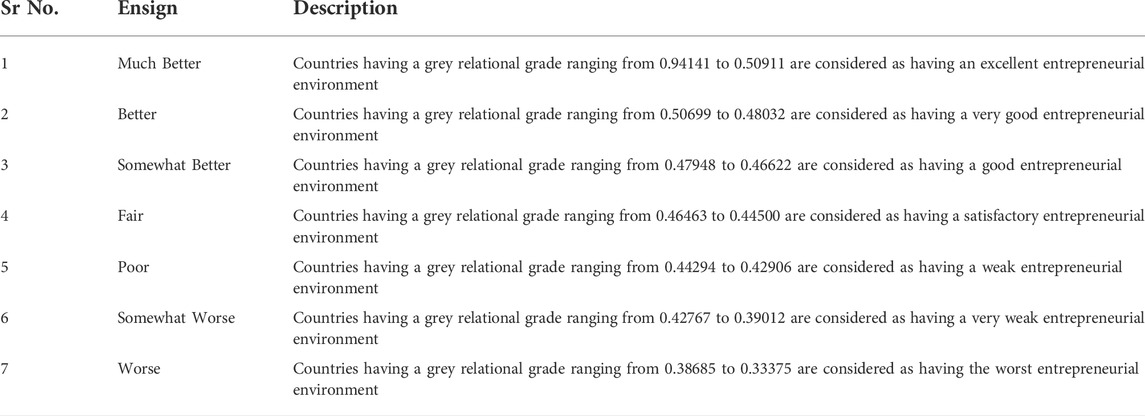
TABLE 8. Scheme of grouping the countries under different ensigns on the basis of grey relational grades.
Results
The importance of entrepreneurship cannot be denied for any country. It is also important to rank countries based on their entrepreneurial environment so that the right policies and decisions can be made. However, there has been scarcity of research in this regard. Therefore, this study has been conducted to fill that gap. This study uses four indicators as proxy of entrepreneurship environment, namely patent applications, trademark applications, new businesses registered and time required to start a business. Patent applications and trademark applications represent innovation, and thus have been used as indicators of entrepreneurial environment. New businesses registered indicates what number of entrepreneurial ventures have been started in any given year in a country. Time required to start a business indicates how easy and quick the process of entrepreneurial venture is in a country. The data on indicators have been collected in the context of 48 countries and analyzed through GRA for the purpose of ranking the countries on the basis of their entrepreneurial environment. The results presented as bold in Table 9 show the proposed ranking of the countries. Furthermore, these countries have been divided into seven categories, based on the ensign method. Countries from rank 1 to 7 are considered to have a “much better” entrepreneurial environment, countries from rank 8 to 14 are considered to have a “better” entrepreneurial environment. In the same way, countries from rank 15 to 21 are considered to have “somewhat better” entrepreneurial environment. In the case of countries from ranking 22 to 28, the entrepreneurial environment is considered to be “fair,” whereas countries from rank 29 to 35 are considered to have a “poor” entrepreneurial environment. Countries from rank 36 to 42 are considered to have a “somewhat worse” entrepreneurial environment, whereas the countries from rank 43 to 48 are considered to having the “worst” entrepreneurial environment.
Discussion
The purpose of the current research is to rank countries on the basis of their entrepreneurial environment using GRA. The data for this purpose have been collected from the World Development Indicators website and analyzed through the GRA to get the ranking of the countries. The results obtained through the analysis are in the form of ranking of the countries, which have been divided in seven groups based on the ensign method, which includes much better, better, somewhat better, fair, poor, somewhat worse and worse. The countries from rank 1 to 7 having grey relational grades of 0.94141 to 0.50911 are considered to have a “much better” entrepreneurial environment. In this group, the top country is United States with 0.94141 grade and Canada is the last with 0.50911 grade. The people in these countries are considered to have the best and developed entrepreneurial mind-set and decision-making power. These countries are best in technology and innovation, they are risk-takers and they have a clear vision about entrepreneurship developments. Next, the countries from rank 8 to 14 have grey relational grades of 0.50699 to 0.48032 and are considered to have a “better” entrepreneurial environment. In this group, the first country is Singapore having 0.50699 grade and Chile is the last having 0.48032 grade. These countries are considered to be enriched with technology and innovation. They are risk-takers and have a clear vision but they do not focus on organizing. Next, the countries from rank 15 to 21 having grey relational grades of 0.47948 to 0.46622 are considered to have a “somewhat better” entrepreneurial environment. In this group, the first country is Belgium having 0.47984 grade and Portugal is the last having 0.46622 grade. These countries are considered to be good in technology and innovation but the people are not risks-takers. They have good decision-making power and are good in organizing. Next, the countries from rank 22 to 28 having grey relational grades of 0.46463 to 0.44500 are considered to have a “fair” entrepreneurial environment. In this group, the first country is Cyprus having 0.46463 grade and Switzerland is the last having 0.44500 grade. These countries are considered to be not good in innovation but the people are risks-takers and are good in organizing. Next, the countries from rank 29 to 35 having grey relational grades of 0.44294 to 0.42906 are considered to have a “poor” entrepreneurial environment. In this group, the first country is Colombia having 0.44294 grade and Montenegro is the last having 0.42906 grade. These countries are considered to have good technology and innovation but the people are not risks-takers. They do not have a developed mind-set and are not having a clear vision. Next, the countries from rank 36 to 42 having grey relational grades of 0.42767 to 0.39012 are considered to have a “somewhat worse” entrepreneurial environment. In this group, the first country is Greece having 0.42767 grade and Costa Rica is the last having 0.39012 grade. These countries are considered to have good technology and innovation but the people are not risks-takers, do not have a developed mind-set, and are not good in organizing. Finally, the countries from rank 43 to 48 have grey relational grades of 0.38685 to 0.33375 and are considered to have “worse” entrepreneurial environment. In this group, the first country is Czech Republic having 0.38685 grade and Namibia is the last having 0.33375 grade. These countries are considered to have poor technology and less innovation. The people are not risks-takers, do not have a developed mind-set, and they are not good in organizing. The current study is compared with relevant contemporary literature, the contrast of which is represented in Table 10.
Three of the research studies seem relevant to be compared. Ertuğrul et al. (2016) focused on ranking of Turkish universities, and compared them on the basis of five different indicators using the secondary data sets and rationalized the ranking of universities. Qazi et al. (2021a) evaluated the immediate response of the countries to the COVID-19 pandemic, and then ranked and classified them on the basis of grey relational grades taking real-time data from “Worldometer.” Giannakitsidou et al. (2020) focused on the environmental and circular economic performance of European countries using data envelopment analysis, and concluded that Belgium is one of the best performers. Keeping in view the contrasting literature, this study is different in context, subject matter, data set, and methodology. It provides new insights on the phenomenon under study. However, the results of the study are sensitive to number of variables, allocation of weights to each variable, and number of alternatives available in data set. Any changes in these factors may result in different composite values of grey relational coefficients/grades, and therefore changes the rankings and ensign classification. The results may also be affected by opting for a different methodology. Therefore, the generalization of results of the study should be interpreted accordingly. However, the methodology and/or procedure used for closing the gap are robust and established enough to give reliable results (Ju-Long, 1982; Wu, 2002; Kuo et al., 2008; Jafarzadeh Ghoushchi et al., 2020).
Conclusion
Entrepreneurship is a well-researched concept in the recent past and in various dimensions, and is considered to be a very important concept because it has a positive impact on the economy of a country. However, there has been scarcity of research regarding the ranking of countries based on entrepreneurial environment. Although there are some indices that rank the countries on this basis, proper scientific research has not been conducted in this regard. This establishes a profound basis for the current study. To bridge this gap, data have been collected regarding the entrepreneurship related variables for 48 countries from the World Development Indicators website and analyzed using GRA. As a result of the analysis, grey relational grades are obtained. On the basis of these grades, the ranking and classification of countries is made on a scale of ‘much better’ to ‘worse’. Countries from rank 1 to 7 have grey relational grades of 0.94141 to 0.50911 and are considered to have a “much better” entrepreneurial environment. In this group, the top country is United States with 0.94141 grade and Canada is the last with 0.50911 grade. Countries from rank 8 to 14 have grey relational grades of 0.50699 to 0.48032 and are considered to have a “better” entrepreneurial environment. In this group, the first country is Singapore having 0.50699 grade and Chile is the last having 0.48032 grade. Countries from rank 15 to 21 have grey relational grades of 0.47948 to 0.46622 and are considered to have a “somewhat better” entrepreneurial environment. In this group, the first country is Belgium having 0.47984 grade and Portugal is the last having 0.46622 grade. Countries from rank 22 to 28 have grey relational grades of 0.46463 to 0.44500 and are considered to have a “fair” entrepreneurial environment. In this group, the first country is Cyprus having 0.46463 grade and Switzerland is the last having 0.44500 grade. Countries from rank 29 to 35 have grey relational grades of 0.44294 to 0.42906 and considered to have a “poor” entrepreneurial environment. In this group, the first country is Colombia having 0.44294 grade and Montenegro is the last having 0.42906 grade. Countries from rank 36 to 42 having grey relational grades of 0.42767 to 0.39012 are considered to have a “somewhat worse” entrepreneurial environment. In this group, the first country is Greece having 0.42767 grade and Costa Rica is the last having 0.39012 grade. Countries from rank 43 to 48 have grey relational grades of 0.38685 to 0.33375 and are considered to have a “worse” entrepreneurial environment. In this group, the first country is Czech Republic having 0.38685 grade and Namibia is the last having 0.33375 grade.
The current paper is valuable for stakeholders as well as readers who want to know the trend of entrepreneurship of different countries. It also has important implications for entrepreneurs, as well as for policy makers. It is a seminal study that have profound theoretical and practical implications for stakeholders. Theoretically, this study provides a framework of scanning comparative sustainable entrepreneurial environment of 48 countries (Awan, et al., 2021). It extends the frontiers of current literature by providing new information about ranking and classification of countries. It also has noteworthy practical implications for stakeholders. For policy makers, and potential and current entrepreneurs, it provides a grey incidence model for understanding current entrepreneurial policies, and for refining and devising new effective policies. For society at large and the international community, it provides lot of new information in the form of grey relational coefficients, grey relational grades, ranks, and classifications for understanding the phenomenon. This has bridged an important research gap in the literature. However, it is worth mentioning the limitations of this study. There are three different categories of limitations (i.e., methodological limitations, data limitations and resources limitations). Methodological limitations are as follows: first, the allocation of weights is done subjectively; second, we could not generate comparative analysis with MCDM techniques; finally, GRA presents trend relationship between an alternative and the ideal alternative and does not present situational relationship, which is possible with other methodologies. Data limitations are as follows: First, the number of proxy variables is limited to four only; second, this study analyzes only 48 countries due to limited availability of data; finally, this study used quantitative secondary data of entrepreneurship, whereas there are many aspects of entrepreneurship that demand purely qualitative measure (e.g., political regimes, socio-cultural factors, and cultural heritage etc.). The resources limitations are as follows: first, the authors are research scholars sitting in public sector universities and are this faced the limitation of scarcity of time; second, this study could not solicit any funding. It is recommended that future researchers should contribute to the literature by taking more countries, ideally the whole list of countries included in GEI, for the purpose of ranking. Future studies should also use different ranking tools and procedures, which have the ability to use the entrepreneurship related indicators to rank the countries accurately. Different techniques can be used in this regard (e.g., TOPSIS, Analytical Network Process, and ELECTRE etc.). Moreover, researchers should also try to find some other indicators that might be useful for ranking of countries on the basis of their entrepreneurial environment.
Data availability statement
The original contributions presented in the study are included in the article/supplementary material, and further inquiries can be directed to the corresponding author.
Author contributions
RZ and FU: Conceptualization, Iitroduction, methodology, interpreted results, writing-original draft preparation.ZB: Visualization, validation, conclusion, writing-original draft preparation. FU: Conceptualization, formal analysis, project administration, and supervision. MS: Finalized manuscript and review and editing. MS and YZ: Literature review, formal analysis, review and editing. SK and YZ: Writing-original draft preparation, review and editing.
Conflict of interest
The authors declare that the research was conducted in the absence of any commercial or financial relationships that could be construed as a potential conflict of interest.
Publisher’s note
All claims expressed in this article are solely those of the authors and do not necessarily represent those of their affiliated organizations, or those of the publisher, the editors and the reviewers. Any product that may be evaluated in this article, or claim that may be made by its manufacturer, is not guaranteed or endorsed by the publisher.
Annex 1: Grey Relational Analysis Algorithm
1 Demonstrating the representation of original data set
An original data set is created and demonstrated using Eq. A1
2 Data Processing
First l, the data (having different measurable units) must be transformed to make them comparable. For this purpose, the data values are transformed into 0–1 interval using one of the following formulae, where
1) If the criterion for the variables is “the larger-the better,” then the data can be normalized using Eq. A2.
2) If the criterion for the variables is “the smaller-the better,” then the data can be normalized using Eq. A3.
3) If the objective is to reach a specific target value, then use Eq. A4 (
4) If there is no specific objective, then normalization can be completed by dividing reference sequence by the first value in the sequence as in Eq. A5.
3 Calculation of Grey Relational Coefficient
After transforming data into comparable form, the grey relational coefficient is calculated using Eq. A6.
where
The largest and the smallest deviations are calculated using Eqs A8, A9.
4 Calculation of Grey Relational Grades
Grey relational grade is simply the weighted sum of grey relational coefficients and calculated using Eq. A9
The grey relational grade represents the level of correlation between the reference sequence and comparable sequence. In case of identical series, the value of grey relational grade is 1
References
Abereijo, I. O. (2016). “Ensuring environmental sustainability through sustainable entrepreneurship,” in Economic modeling, analysis, and policy for sustainability (IGI Global), 234–249.
Acs, Z. J., and Szerb, L. (2010). The global entrepreneurship and development index (GEDI). Paper presented at the Summer Conference.
Ács, Z. J., Szerb, L., and Autio, E. (2017). “Global entrepreneurship and development index Springer Briefs in Economics,” in Global Entrepreneurship and Development Index 2016, 19–38. Springer.
Afawubo, K., and Noglo, Y. A. (2022). ICT and entrepreneurship: A comparative analysis of developing, emerging and developed countries. Technol. Forecast. Soc. Change 175, 121312. doi:10.1016/j.techfore.2021.121312
Afza, T., and Rashid, M. A. (2009). Marginalized women social well‐being through enterprise development: A glimpse of remote women status in Pakistan. J. Ent. Emerg. 1, 248–267. doi:10.1108/17561390910999533
Ahlstrom, D., and Ding, Z. (2014). Entrepreneurship in China: An overview. Int. Small Bus. J. 32 (6), 610–618. doi:10.1177/0266242613517913
Amorós, J. E., Bosma, N., and Levie, J. (2013). Ten years of global entrepreneurship monitor: Accomplishments and prospects. Int. J. Entrepreneurial Ventur. 5 (2), 120–152. doi:10.1504/ijev.2013.053591
Asgharnezhad, A., and Darestani, S. A. (2022). A green supplier selection framework in polyethylene industry. Manag. Res. Rev [Epub ahead of print]. doi:10.1108/mrr-01-2021-0010
Awan, U., and Jabbour, C. J. (2022). Guest Editorial: Socially responsible and sustainable operations through digital transformation: Deepening understanding of digital tools in operations management. TQM J. 34 (2), 229–231. doi:10.1108/tqm-03-2022-329
Awan, U., and Sroufe, R. (2022). Sustainability in the circular economy: Insights and dynamics of designing circular business models. Appl. Sci. 12 (3), 1521. doi:10.3390/app12031521
Awan, U., Bhutta, M. K. S., Huiskonen, J., and Kraslawski, A. (2021). “Deployment of sustainable development framework in export manufacturing firms for the common good,” in Integrating social responsibility and sustainable development (Cham: Springer), 133–150.
Awan, U., Hannola, L., Tandon, A., Goyal, R. K., and Dhir, A. (2022). Quantum computing challenges in the software industry. A fuzzy AHP-based approach. Inf. Softw. Technol. 147, 106896. doi:10.1016/j.infsof.2022.106896
Awan, U. (2021). “Steering for sustainable development goals: A typology of sustainable innovation,” in Industry, innovation and infrastructure (Cham: Springer International Publishing), 1026–1036.
Aydemir, E., and Sahin, Y. (2019). “Evaluation of healthcare service quality factors using grey relational analysis in a dialysis center,” in Grey systems: Theory and application.
Basit, A., Asghar, W., Niazi, A. A. K., and Qazi, T. F. (2021). Excavating future challenges: An analysis of health systems of one hundred-six countries. J. Bus. Soc. Rev. Emerg. Econ. 7 (2), 219–230. doi:10.26710/jbsee.v7i2.1640
Baycan-Levent, T., and Nijkamp, P. (2009). Characteristics of migrant entrepreneurship in Europe. Entrepreneursh. Regional Dev. 21 (4), 375–397. doi:10.1080/08985620903020060
Bergmann, H. (2011). Entrepreneurship disparities within Switzerland–Do tax and language differences play a role? Entrepreneursh. Regional Dev. 23 (7-8), 523–548. doi:10.1080/08985620903508932
Cervelló-Royo, R., Moya-Clemente, I., Perelló-Marin, M. R., and Ribes-Giner, G. (2022). A configurational approach to a country’s entrepreneurship level: Innovation, financial and development factors. J. Bus. Res. 140, 394–402. doi:10.1016/j.jbusres.2021.11.009
Cheng, Y., Awan, U., Ahmad, S., and Tan, Z. (2021). How do technological innovation and fiscal decentralization affect the environment? A story of the fourth industrial revolution and sustainable growth. Technol. Forecast. Soc. Change 162, 120398. doi:10.1016/j.techfore.2020.120398
Chiroli, D. M. D. G., Solek, É. A., Oliveira, R. S., Barboza, B. M., Campos, R. P. D., and Kovaleski, J. L. (2022). Using multi-criteria analysis for smart city assessment. Cidades: Comunidades e Territórios.
Cumming, D., Johan, S., and Zhang, M. (2014). The economic impact of entrepreneurship: Comparing international datasets. Corp. Gov. Int. Rev. 22 (2), 162–178. doi:10.1111/corg.12058
Dionisio, E. A., Júnior, E. I., and Fischer, B. B. (2021). Country-level efficiency and the index of dynamic entrepreneurship: Contributions from an efficiency approach. Technol. Forecast. Soc. Change 162, 120406. doi:10.1016/j.techfore.2020.120406
Ecer, F. (2022). An extended MAIRCA method using intuitionistic fuzzy sets for coronavirus vaccine selection in the age of COVID-19. Neural comput. Appl. 34 (7), 5603–5623. doi:10.1007/s00521-021-06728-7
Ertuğrul, İ., Öztaş, T., Özçil, A., and Öztaş, G. Z. (2016). Grey relational analysis approach in academic performance comparison of university a case study of Turkish universities. Eur. Sci. J., 1857–7431.
Fang, T. Y., Lin, S. W., Lo, H. W., and Wu, C. H. (2022). Southeast asian nations’ regional competitiveness: An exploration through grey relational analysis. Technol. Econ. Dev. Econ. 28 (5), 1287–1312. doi:10.3846/tede.2022.17033
Frisch Aviram, N., Cohen, N., and Beeri, I. (2020). Policy entrepreneurship in developing countries: A systematic review of the literature. Public Adm. Dev. 40 (1), 35–48. doi:10.1002/pad.1852
Gerus-Gościewska, M., and Gościewski, D. (2022). Grey relational analysis (GRA) as an effective method of research into social preferences in urban space planning. Land 11 (1), 102. doi:10.3390/land11010102
Giannakitsidou, O., Giannikos, I., and Chondrou, A. (2020). Ranking European countries on the basis of their environmental and circular economy performance: A dea application in msw. Waste Manag. 109, 181–191. doi:10.1016/j.wasman.2020.04.055
Gigović, L., Pamučar, D., Bajić, Z., and Milićević, M. (2016). The combination of expert judgment and GIS-MAIRCA analysis for the selection of sites for ammunition depots. Sustainability 8 (4), 372. doi:10.3390/su8040372
Gu, W., and Wang, J. (2022). Research on index construction of sustainable entrepreneurship and its impact on economic growth. J. Bus. Res. 142, 266–276. doi:10.1016/j.jbusres.2021.12.060
Guindalini, C., Verreynne, M.-L., and Kastelle, T. (2021). Taking scientific inventions to market: Mapping the academic entrepreneurship ecosystem. Technol. Forecast. Soc. Change 173, 121144. doi:10.1016/j.techfore.2021.121144
Hébert, R. F., and Link, A. N. (2006). The entrepreneur as innovator. J. Technol. Transf. 31 (5), 589–597. doi:10.1007/s10961-006-9060-5
Hezer, S., Gelmez, E., and Özceylan, E. (2021). Comparative analysis of TOPSIS, VIKOR and COPRAS methods for the COVID-19 regional safety assessment. J. Infect. public health 14 (6), 775–786. doi:10.1016/j.jiph.2021.03.003
Hwang, C. L., and Yoon, K. (1981). “Methods for multiple attribute decision making,” in Multiple attribute decision making (Berlin, Heidelberg: Springer), 58–191.
Jafarzadeh Ghoushchi, S., Ab Rahman, M. N., Raeisi, D., Osgooei, E., and Jafarzadeh Ghoushji, M. (2020). Integrated decision-making approach based on SWARA and GRA methods for the prioritization of failures in solar panel systems under Z-information. Symmetry 12 (2), 310. doi:10.3390/sym12020310
Jing, S., Qinghua, Z., and Landström, H. (2015). Entrepreneurship research in three regions-the USA, Europe and China. Int. Entrep. Manag. J. 11 (4), 861–890. doi:10.1007/s11365-014-0315-6
Ju-Long, D. (1982). Control problems of grey systems. Syst. control Lett. 1 (5), 288–294. doi:10.1016/s0167-6911(82)80025-x
Juma, N. A., James, C. D., and Kwesiga, E. (2017). Sustainable entrepreneurship in Sub-Saharan Africa: The collaborative multi-system model. J. Small Bus. Entrepreneursh. 29 (3), 211–235. doi:10.1080/08276331.2017.1293949
Kantis, H. D., Federico, J. S., and García, S. I. (2020). Entrepreneurship policy and systemic conditions: Evidence-based implications and recommendations for emerging countries. Socio-Economic Plan. Sci. 72, 100872. doi:10.1016/j.seps.2020.100872
Kanwal, N., and Awan, U. (2021). “Role of design thinking and biomimicry in leveraging sustainable innovation,” in Industry, innovation and infrastructure. Encyclopedia of the UN sustainable development goals. doi:10.1007/978-3-319-71059-4_86-1
Keršuliene, V., Zavadskas, E. K., and Turskis, Z. (2010). Selection of rational dispute resolution method by applying new step‐wise weight assessment ratio analysis (SWARA). J. Bus. Econ. Manag. 11 (2), 243–258. doi:10.3846/jbem.2010.12
Kuo, Y., Yang, T., and Huang, G. W. (2008). The use of grey relational analysis in solving multiple attribute decision-making problems. Comput. industrial Eng. 55 (1), 80–93. doi:10.1016/j.cie.2007.12.002
Lafuente, E., Szerb, L., and Acs, Z. J. (2016). Country level efficiency and national systems of entrepreneurship: A data envelopment analysis approach. J. Technol. Transf. 41 (6), 1260–1283. doi:10.1007/s10961-015-9440-9
Lepoutre, J., Justo, R., Terjesen, S., and Bosma, N. (2013). Designing a global standardized methodology for measuring social entrepreneurship activity: The global entrepreneurship monitor social entrepreneurship study. Small Bus. Econ. 40 (3), 693–714. doi:10.1007/s11187-011-9398-4
Levie, J., Autio, E., Acs, Z., and Hart, M. (2014). Global entrepreneurship and institutions: An introduction. Small Bus. Econ. 42 (3), 437–444. doi:10.1007/s11187-013-9516-6
Lin, S., and Lasserre, P. (2015). Entrepreneurship research amid transitional economies: Domains and opportunities. Chin. Manag. Stud. 9, 123–129. doi:10.1108/cms-03-2015-0053
Majeed, R. A., and Breesam, H. K. (2021). Application of SWARA technique to find criteria weights for selecting landfill site in baghdad governorate IOP conference series: Mater. IOP Conf. Ser. Mater. Sci. Eng. 1090 (1), 012045. doi:10.1088/1757-899x/1090/1/012045
Mathew, M., Chakrabortty, R. K., Ryan, M. J., Ljaz, M. F., and Khan, S. A. R. (2021). The multi-attributive border approximation area comparison (mabac) method for decision making under interval-valued fermatean fuzzy environment for green supplier selection. [Preprints, 2021120209]. doi:10.20944/preprints202112.0209.v1
Moore, E. M., Dau, L. A., and Doh, J. (2020). Does monetary aid catalyse new business creation? Analysing the impact of global aid flows on formal and informal entrepreneurship. J. Manage. Stud. 57 (3), 438–469. doi:10.1111/joms.12552
Morozova, I. A., Popkova, E. G., and Litvinova, T. N. (2019). Sustainable development of global entrepreneurship: Infrastructure and perspectives. Int. Entrep. Manag. J. 15 (2), 589–597. doi:10.1007/s11365-018-0522-7
Nguyen, C. P., Nguyen, B., Tung, B. D., and Su, T. D. (2021). Economic complexity and entrepreneurship density: A non-linear effect study. Technol. Forecast. Soc. Change 173, 121107. doi:10.1016/j.techfore.2021.121107
Niazi, A., Qazi, T. F., and Basit, A. (2021a). Evaluating unemployment through grey incidence analysis model: A study of one hundred thirteen selected countries. Glob. Reg. Rev. VI 6, 23–35. doi:10.31703/grr.2021(vi-i).04
Niazi, A., Qazi, T. F., Basit, A., and Shaukat, M. Z. (2021b). Evaluation of climate of selected sixty-six countries using grey relational analysis: Focus on Pakistan. J. Bus. Soc. Rev. Emerg. Econ. 7 (1), 51–62.
Opricovic, S. (1998). Visekriterijumska optimizacija u građevinarstvu-Multi-criteria optimization of civil engineering systems. Belgrade: Faculty of Civil Engineering.
Pamučar, D., and Ćirović, G. (2015). The selection of transport and handling resources in logistics centers using Multi-Attributive Border Approximation Area Comparison (MABAC). Expert Syst. Appl. 42 (6), 3016–3028. doi:10.1016/j.eswa.2014.11.057
Pamučar, D., Stević, Ž., and Sremac, S. (2018). A new model for determining weight coefficients of criteria in mcdm models: Full consistency method (fucom). Symmetry 10 (9), 393. doi:10.3390/sym10090393
Pinillos, M.-J., and Reyes, L. (2011). Relationship between individualist–collectivist culture and entrepreneurial activity: Evidence from global entrepreneurship monitor data. Small Bus. Econ. 37 (1), 23–37. doi:10.1007/s11187-009-9230-6
Pramanik, P. K. D., Biswas, S., Pal, S., Marinković, D., and Choudhury, P. (2021). A comparative analysis of multi-criteria decision-making methods for resource selection in mobile crowd computing. Symmetry 13 (9), 1713. doi:10.3390/sym13091713
Qazi, T., Niazi, A. A. K., and Basit, A. (2021a). Assessment of agricultural performance of districts of Punjab based on composite agricultural indicators using grey relational analysis. Glob. Soc. Sci. Rev. VI (I), 158–172. doi:10.31703/gssr.2021(vi-i).16
Qazi, T., Shaukat, M. Z., Niazi, A. A. K., and Basit, A. (2021b). Evaluating the immediate response of country-wide health systems to the covid-19 pandemic: Applying the gray incidence analysis model. Front. Public Health 9, 635121. doi:10.3389/fpubh.2021.635121
Qian, H., and Liu, S. (2018). Cultural entrepreneurship in US cities. J. Urban Aff. 40 (8), 1043–1065. doi:10.1080/07352166.2018.1468223
Qian, J., Kammerlander, N., and Darwin, S. (2021). Digital entrepreneurship in developing countries: The role of institutional voids. Technol. Forecast. Soc. Change 170, 120876. doi:10.1016/j.techfore.2021.120876
Rosário, A. T., Raimundo, R. J., and Cruz, S. P. (2022). Sustainable entrepreneurship: A literature review. Sustainability 14 (9), 5556. doi:10.3390/su14095556
Saaty, T. L. (1977). A scaling method for priorities in hierarchical structures. J. Math. Psychol. 15 (3), 234–281. doi:10.1016/0022-2496(77)90033-5
Stefan, D., Vasile, V., Popa, M. A., Cristea, A., Bunduchi, E., Sigmirean, C., et al. (2021). Trademark potential increase and entrepreneurship rural development: A case study of southern transylvania, Romania. PloS one 16 (1), e0245044. doi:10.1371/journal.pone.0245044
Tasnim, N., and Afzal, M. N. I. (2018). An empirical investigation of country level efficiency and national systems of entrepreneurship using Data Envelopment Analysis (DEA) and the TOBIT model. J. Glob. Entrepr. Res. 8 (1), 37–17. doi:10.1186/s40497-018-0138-y
Thompson, J. L., and Scott, J. (2010). Environmental entrepreneurship: The sustainability challenge. Available at: http://nrl.northumbria.ac.uk/id/eprint/29958/last (accessed on 07 08, 2022).
Wei, Y. (2022). Regional governments and opportunity entrepreneurship in underdeveloped institutional environments: An entrepreneurial ecosystem perspective. Res. Policy 51 (1), 104380. doi:10.1016/j.respol.2021.104380
Wennekers, S. (2006). Entrepreneurship at country level: Economic and non-economic determinants. Erasmus Research Institute of Management (ERIM) RSM Erasmus University / Erasmus School of Economics Erasmus University Rotterdam.
Williams, C. C., and Shahid, M. S. (2016). Informal entrepreneurship and institutional theory: Explaining the varying degrees of (in) formalization of entrepreneurs in Pakistan. Entrepreneursh. Regional Dev. 28 (1-2), 1–25. doi:10.1080/08985626.2014.963889
World Development Indicators (2021). Worldbank. Available at: https://databank.worldbank.org/source/world-development-indicators# (Last accessed on 07 26, 2022).
Wu, H. H. (2002). A comparative study of using grey relational analysis in multiple attribute decision making problems. Qual. Eng. 15 (2), 209–217. doi:10.1081/qen-120015853
Wymenga, P., Spanikova, V., Derbyshire, J., and Barker, A. (2011). Are Eu smes recovering from the crisis?. Annual Report on EU Small and Medium sized Enterprises 2010/2011. Rotterdam and Cambridge: European Comission.
Yoganandan, G., and Vasan, M. (2022). Evaluating the quality of scientific research papers in entrepreneurship. Qual. Quant. 56, 3013–3027. doi:10.1007/s11135-021-01254-z
Zahra, S. A., Liu, W., and Si, S. (2022). How digital technology promotes entrepreneurship in ecosystems. Technovation. doi:10.1016/j.technovation.2022.102457
Zavadskas, E., Kaklauskas, A., and Šarka, V. (1994). The new method of multicriteria complex proportional assessment of projects. Technol. Econ. Dev. Econ. 1, 131–139.
Keywords: entrepreneurship, entrepreneurial environment, countries’ ranking, grey relational analysis, innovation
Citation: Zhu R, Bhutta ZM, Zhu Y, Ubaidullah F, Saleem M and Khalid S (2022) Grey relational analysis of country-level entrepreneurial environment: A study of selected forty-eight countries. Front. Environ. Sci. 10:985426. doi: 10.3389/fenvs.2022.985426
Received: 03 July 2022; Accepted: 10 August 2022;
Published: 07 October 2022.
Edited by:
Usama Awan, Lappeenranta University of Technology, FinlandReviewed by:
Dragan Pamucar, University of Defence in Belgarde, SerbiaUmer Shahzad, Anhui University of Finance and Economics, China
Copyright © 2022 Zhu, Bhutta, Zhu, Ubaidullah, Saleem and Khalid. This is an open-access article distributed under the terms of the Creative Commons Attribution License (CC BY). The use, distribution or reproduction in other forums is permitted, provided the original author(s) and the copyright owner(s) are credited and that the original publication in this journal is cited, in accordance with accepted academic practice. No use, distribution or reproduction is permitted which does not comply with these terms.
*Correspondence: Yong Zhu, zhuyong@mail.hnust.edu.cn
 Rui Zhu1
Rui Zhu1  Fizza Ubaidullah
Fizza Ubaidullah Madiha Saleem
Madiha Saleem Sidra Khalid
Sidra Khalid